In pursuit of local cuisine…
Updated on 17 June, 2021.
When we travel somewhere for pleasure, we probably do so to discover experiences that are different from our normal routine (even if it’s just a simple countryside or downtown walk). So what about wine and food? Local wine plus local food? Priorat is an impressive choice in this regard. This wine county has been little affected by globalization. These two previous opuses on how to get to Priorat and how to book your experiences around the area will help articulate that.
Priorat was a secluded area for nearly a century following the phylloxera disaster. So the population that didn’t emigrate from here and stayed working on the mountainous farmland somehow preserved the traditional rural cookery that wasn’t so exciting in the times when only urban tricks gave you kicks.
And when Priorat’s bold and delicious wine started to resurface on the global arena, that was the moment of glory for local chefs to show visitors something that Barcelona seems to have irrevocably lost to the “paella, sangria, ole-ole” tourist-trap drivel.
Focus on local food…
Priorat has no chain restaurants (touch wood). And food delivery / takeaway has only recently appeared as a response to the covid-19-related restrictions, grocery shops are mostly small and local (except one and a half supermarkets where household detergents are the biggest highlight). You still can find here some “pizzoids” and “muffinoids” (some of them are of quite decent quality, I grant you), but you won’t learn about that from me. If you search for Thai / Japanese / Italian / Mexican / Klingon food, stay where you live, don’t come to Priorat.
If you crave locally made cuisine from a unique region in Spain, keep reading this post. For specific restaurant recommendations, scroll down.
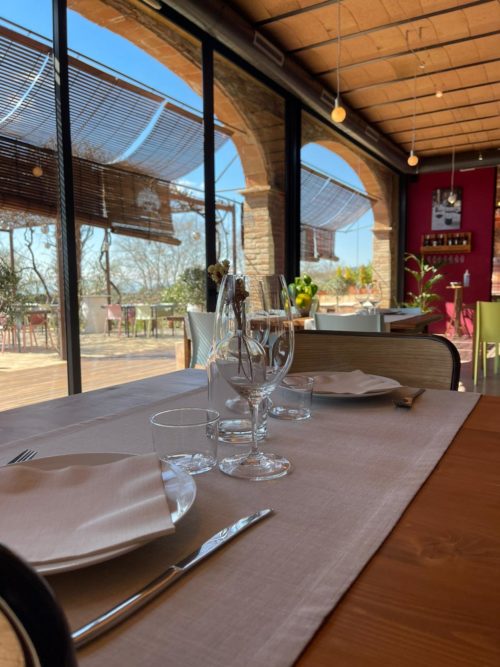
Priorat Savouries
Given that Priorat is a landlocked region, its cuisine is typically Catalan continental, with some moderate coastal gastronomic influence. Classical savoury recipes would include “llangonissa amb fesols” (grilled sausage with beans), “corder a la brasa” (grilled lamb), “botifarra negra” (sort of black pudding). All of them are often served with one of Catalonia’s best-known dressings: all-i-oli (aioli). Excellent pairings for bold DOQ Priorat and DO Montsant red wines.
“Caragols” (Priorat Catalan name for snails) are another local delicacy, attractive to those who are into Burgundy-style escargots and who love snails in general. The serving size is usually larger than six items and they come in different styles: spicy and sweet, sautéed or boiled, with different dressings, or sometimes with a generous piece of rabbit meat (“conill amb caragols”). NB: rabbit is a relatively common lean meat in Spain. These can pair with Priorat red Grenache-based wines.
The closest paddy fields are located in the neighbouring seaside area called the Ebro Delta, so rice-based food is quite common in Priorat. You won’t necessarily see the word “paella” on the menu. Rather, the dish would appear as “rice” or “arròs.” It would be typically “arròs amb bacallà” (rice and cod) or “arròs amb verdures” (rice and vegetables). Choose some local light red wine, or a Priorat white wine (white Grenache, Macabeu, Pedro Ximénez, etc.).
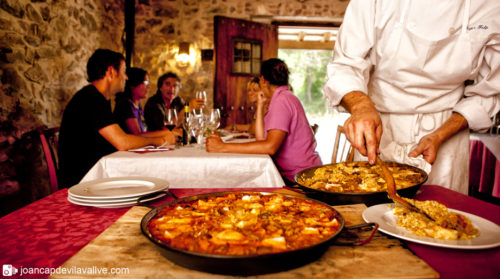
Because Catalonia’s inland counties generally have colder winters than its seaside, don’t be surprised to find plenty of “comfort” food items on the menu. Special winter highlights would be “escudella” (type of stocky soup), “calçots” (roasted long onions) and “truita amb suc” (gravy omelette, further details below). Some local sturdy red wines (maybe even young ones) match wonderfully with these dishes.
Escudella soup
“Escudella” is a classical Catalan winter soup, available year-round, but probably not your first choice for summer lunch. Traditionally, it contained all meat-and-vegetable leftovers that people would put in the same pot and simmer for days. For example, chicken, pork, ham, sausage, black pudding, carrots, potatoes, parsnips, onions, chickpeas, celery, etc. Nowadays, the ingredients are high quality, but the tradition is still kept up.
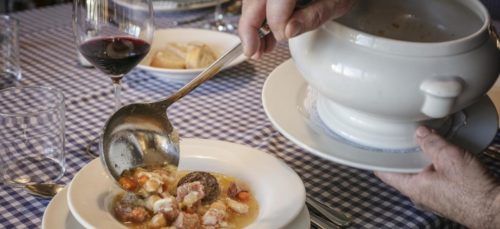
Winetraveler Tip: If you choose it as part of your set lunch menu, ask to wrap the main course to take away: “escudella” is way too substantial!
Highly seasonal savouries include “calçots” (a type of long onion, but not leeks!) roasted over a bonfire and served with a very thick nut-based dip called “romesco”. Patrons typically have calçots and romesco as a starter for their winter barbecues. “Calçots” come in bundles and are either served in a newspaper or on a roof tile to keep them warm. People peel the charcoaled skin, dip the onion core in the romesco dressing and swallow it. Usually, there’s a bib to protect your chest, some eaters also wear plastic gloves.
Truita amb suc: Priorat’s Gravy Omelette
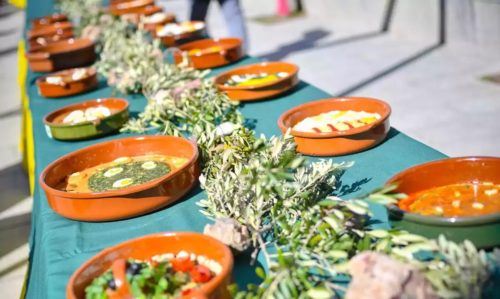
You can actually cook “truita amb suc” all year round, but it’s more typical of winter. Roser Vernet and Minerva Pi, renowned experts in Priorat’s local cuisine, remark in their book that it’s “one of Priorat’s epitomical dishes.” It’s probably the best-known original Priorat’s savoury. The town of Ulldemolins even hosts an annual omelette foodie festival featuring a recipe contest. So, the main ingredients break down into three: the gravy (simmered tomatoes, parsley, garlic, flour, paprika and ground almonds), the omelette itself (stuffed either with beans or spinach, or both) and some chunks of codfish. The latter two are placed in the gravy and warmed up. If this appeals to you, here’s a recipe video made by Televisió de Catalunya. Find one of the most traditional recipes of “truita amb suc” in this text (attached PDF).
And for dessert…
Some locals claim “orelletes” (“small ears”) to be Priorat’s most typical dessert. They’re crunchy fried, anise-flavored dough flatbreads. You might find them in the most rustic local restaurants. Other sweet delicacies include “menjar blanc de Reus” (delicious almond-based blancmange), “postres de músic” (nuts and dried fruit), “codonyat amb formatge” (quince jelly with cheese) and “mel i mató” (honey and cottage cheese). Who’d rule out “crema catalana” sprinkled with a tinge of cinnamon?
Useful Priorat Wine-and-Dine Tips & Links
There are certainly many more savouries and puddings to explore on the restaurant menus throughout Priorat. However, these additional handy tips might help you. If you’d like to try calçots, choose to visit Priorat somewhere between December and April. Many places serve them in winter. For example you could try making a reservation with Mas Trucafort or Clos Figueras. Out of the currently existing restaurants, the “truita amb suc” at Hostal Sport and La Font is excellent.
Interestingly, pure fusion cuisine is a bit hard to find in Priorat, however, you might be interested in some innovative techniques based on traditional Catalan cookery. Try La Cuina del Cairat or Quinoa in Falset. If you feel like trying a fusion restaurant to enjoy more international ingredients and techniques, try Brots.
You can browse the different Priorat restaurants at the same webs: Priorat Enoturisme (Priorat Wine Experience) and Priorat Tourism Information Office.
I’ve been writing this post during the covid-19 lockdown here in Priorat. Once the pandemic is over and things look up a bit, I hope to host you here. Let’s raise our wine glasses! Cheers!
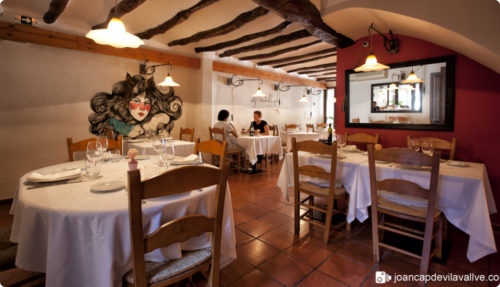
More Ways To Plan and Explore Catalonia
An Overview of the Catalan Wine Region
Here’s a Practical Itinerary For Visiting Priorat
How To Get To, From and Around Priorat Spain
DO, DOCa and DOQ: What’s The Difference Between These Wine Classifications?
9 Places To Enjoy Wine in Barcelona
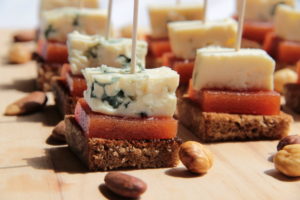
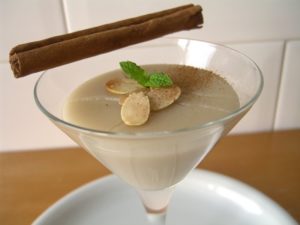
Wow – talk about culinary adventure! I will be digging up this article again whenever I can get back to Spain. Salud!